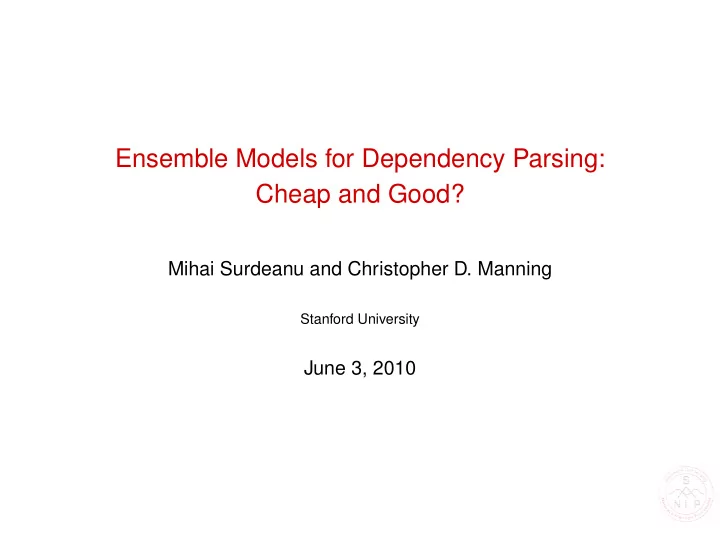

Ensemble Models for Dependency Parsing: Cheap and Good? Mihai Surdeanu and Christopher D. Manning Stanford University June 3, 2010
Ensemble Parsing Parser ¡2 ¡ Parser ¡1 ¡ Parser ¡3 ¡ Ensemble ¡Parser ¡ Parser ¡4 ¡ Parser ¡6 ¡ Parser ¡5 ¡
Ensemble Parsing Parser ¡2 ¡ Parser ¡1 ¡ Parser ¡3 ¡ ? ¡ Ensemble ¡Parser ¡ Parser ¡4 ¡ Parser ¡6 ¡ Parser ¡5 ¡ Many questions still unanswered despite all the previous work This work: empirical answers for projective English dependency parsing
Setup Corpus: syntactic dependencies of the CoNLL 2008-09 shared tasks 7 individual parsing models: Devel In domain Out of domain LAS LAS LAS MST 85.36 87.07 80.48 Malt → 84.24 85.96 78.74 AE Malt → 83.75 85.61 78.55 CN Malt → 83.74 85.36 77.23 AS Malt ← 82.43 83.90 76.69 AS Malt ← 81.75 83.53 77.29 CN Malt ← 80.76 82.51 76.18 AE
Scoring Models for Parser Combination Parser ¡3 ¡ Parser ¡1 ¡ Parser ¡2 ¡ Dependency ¡Scoring ¡ Output ¡Construc<on ¡ Ensemble ¡
Scoring Models for Parser Combination Parser ¡3 ¡ Parser ¡1 ¡ Parser ¡2 ¡ Dependency ¡Scoring ¡ Output ¡Construc<on ¡ Ensemble ¡ Which scoring model is best? → Unweighted voting? → Weighted voting? Weighted by what? → Meta-classification?
Scoring Models: Voting Unweighted Weighted by Weighted by Weighted by ... POS of modifier label of dep. dep. length LAS LAS LAS LAS 3 86.03 86.02 85.53 85.85 4 86.79 86.68 86.38 86.46 5 86.98 86.95 86.60 86.87 6 87.14 87.17 86.74 86.91 7 86.81 86.82 86.50 86.71 Weighting does not really make a difference! More individual parsers helps, but up to a point.
Scoring Models: Meta-classification Can we improve dependency scoring through meta-classification?
Scoring Models: Meta-classification Can we improve dependency scoring through meta-classification? No. We implemented a L2-regularized logistic regression classifier → using as features: identifiers of the base models, POS tags of head and modifier, labels of dependencies, length of depen- dencies, length of sentence, and combinations of the above. No improvement over the unweighted voting approach. →
Meta-classification Analysis Minority dependencies (MD): dependencies that disagree with the majority vote. Precision of MDs: ratio of MDs in a given context (e.g., POS of modifier is NN and parser is MST) that are correct. Meta-classification can outperform majority vote only when the number of MDs in contexts with precision > 50 % is large. → But these are less than 0.7% of total dependencies!
Re-parsing Algorithms Parser ¡1 ¡ Parser ¡2 ¡ Parser ¡3 ¡ Dependency ¡Scoring ¡ Output ¡Construc<on ¡ Ensemble ¡ How common are badly-formed trees for word-by-word combination? Which is the best re-parsing strategy?
Re-parsing Algorithms In domain Out of domain Zero roots 0.83% 0.70% Multiple roots 3.37% 6.11% Cycles 4.29% 4.23% Total 7.46% 9.64% Percentage of badly-formed trees for word-by-word combination
Re-parsing Algorithms In domain Out of domain Zero roots 0.83% 0.70% Multiple roots 3.37% 6.11% Cycles 4.29% 4.23% Total 7.46% 9.64% Percentage of badly-formed trees for word-by-word combination In domain Out of domain LAS LAS Word by word ( O ( N ) ) 88.89 82.13 ∗ Eisner (exact – O ( N 3 ) ) 88.83 ∗ 81.99 Attardi (approximate – O ( N ) ) 88.70 81.82 Performance of re-parsing algorithms Badly-formed trees are common! But approximate re-parsing algorithms perform as well as exact ones! ∗ indicates statistical significance over the next lower ranked model
Combination Strategies How important is it to combine parsers at learning time? → E.g., stacking: MST Malt = MST + Malt features
Combination Strategies How important is it to combine parsers at learning time? → E.g., stacking: MST Malt = MST + Malt features In domain Out of domain LAS LAS ensemble 3 88.83 ∗ 81.99 ∗ 100 % ensemble 1 88.01 ∗ 80.78 100 % ensemble 3 87.45 81.12 50 % 87.45 ∗ 80.25 ∗ MST Malt ensemble 1 86.74 79.44 50 % The advantages gained from combining parsers at learning time can be easily surpassed by runtime combination models that have access to more base parsers! The ensemble models are more robust out of domain
Comparison with State of the Art Parsers In domain Out of domain LAS LAS 90.13 ∗ 82.81 ∗ CoNLL 2008 #1 (Johansson and Nugues) ensemble 3 88.83 ∗ 81.99 ∗ 100 % 88.14 80.80 CoNLL 2008 #2 (Zhang et al.) ensemble 1 88.01 80.78 100 % Our best ensemble model is second In the out-of-domain corpus, performance is within 1% LAS of a parser that uses second-order features and is O ( N 4 ) The ensemble models are more robust out of domain
Conclusion: Less Is More The diversity of base parsers is more important than complex learning models for parser combination (e.g., meta-classification, stacking) Well-formed dependency trees can be guaranteed without significant performance loss by linear-time approximate re-parsing algorithms Unweighted voting performs as well as weighted voting for the re-parsing of candidate dependencies Ensemble parsers that are both accurate and fast can be rapidly developed with minimal effort
Thank you! Many thanks to Johan Hall, Joakim Nivre, Ryan McDonald, and Giuseppe Attardi Code: www.surdeanu.name/mihai/ensemble/ Questions?
Recommend
More recommend